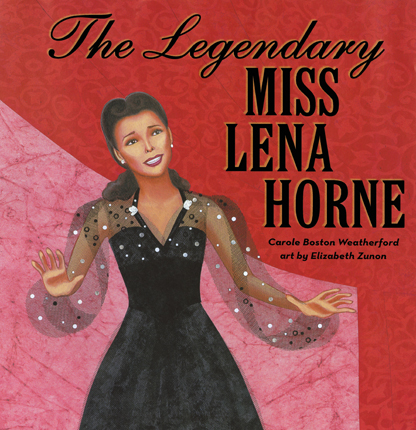Full Text Reviews: School Library Journal - 11/01/2016 Gr 3–5—A lyrical biography from award-winning author Weatherford (Voice of Freedom: Fannie Lou Hamer, Spirit of the Civil Rights Movement). The narrative follows Horne throughout her life and highlights her talent, activism, career highs and lows, love of reading, and lifelong dedication to civil rights. While the format is that of a picture book, the text, which alternates between short phrases and longer narrative paragraphs, may require a sophisticated reader. Complex concepts (studio contracts, blacklisting, lynching) are neither glossed over nor extensively addressed. Where this volume truly shines, though, is in its straightforward but multifaceted approach to the complicated realities of Horne's stardom, from segregated venues to skin-darkening makeup, contract negotiations to civil rights rallies and parenting. Weatherford celebrates Horne for her skill and for changing the game for those to come ("Because Lena refused/to darken rear doors,/black stars now gleam/on red carpets"). Zunon's paint and collage illustrations fill the pages with rich colors and remain true to the glamor of Horne's performances. Occasional text boxes featuring song titles or quotations work to varying success. Back matter includes an author's note about Weatherford's own connection with Horne and a list of further reading (however, the two print suggestions are written for older students). VERDICT Though it will likely need some selling on the part of librarians, this is a carefully crafted offering for thoughtful readers interested in the intersection of music, stardom, and civil rights.—Katya Schapiro, Brooklyn Public Library - Copyright 2016 Publishers Weekly, Library Journal and/or School Library Journal used with permission. Bulletin for the Center... - 01/01/2017 The entertainment field was the last career young Lena Horne’s college-educated, activist grandmother would have advised for the child she helped raise during Lena’s parents’ frequent absences. Lena put her grandmother’s ideals on hold, however, trailing along with her performer mother from boarding house to boarding house, leaving school to join the chorus line at the Cotton Club, landing a gig with the black Noble Sissle Society Orchestra, and even becoming lead vocalist for the all-white Charlie Barnet Orchestra. As Horne’s career progressed from stage to screen, racial activism resurfaced in her life, and she became a standard bearer for blacks’ full participation in the entertainment industry, waging “a one-woman war against stereotypes by refusing to play maids and mammies onscreen.” Weatherford marks the highlights of a long career, focusing on the many lines in the sand Horne drew as she fought the segregation system during World War II, was blacklisted during the Joseph McCarthy era, and supported the 1963 March on Washington, all while retaining her polish and glamor. Such a luminous career demands compelling biographical treatment, but Weatherford eschews her customary poetry format, one that could have added a touch of jazz and showmanship, and instead uses a plainspoken prose style that, though accessible, is mostly lackluster. Likewise, Zunon’s oil and collage illustrations are more informative than engrossing, with flat backgrounds and stiff figures; the pair of photographs of Lena in her early years are likely to leave a more lasting impression. An author’s note and bibliography are included, but suggestions for “Further Reading, Listening, and Viewing” are bound to prove even more useful leads for readers intrigued by the stunning Miss Horne. EB - Copyright 2017 The Board of Trustees of the University of Illinois. Loading...
|



